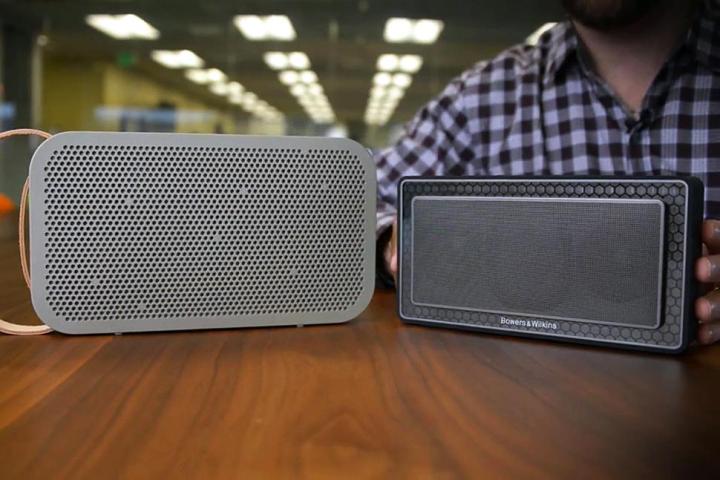
Recognizing a prime time to strike, two premium audio companies have released their takes on portable Bluetooth speakers, resulting in Bowers & Wilkins’ T7, and the Bang & Olufsen Beoplay A2. Both speakers are unique in design, portable, and packed with the kind of premium components you’d expect from their regal lineage. At $350 and $400 respectively, both beg a premium price point, too. But which is better? For those looking to go big in Bluetooth, we’ve pitted these speakers against one another in an all-out dogfight.
Aesthetics
Both the T7 and A2 offer designs that will catch some eyes at your next camping trip or BBQ — or perhaps more appropriately, given the price, your next get together at Chet’s ski chalet.
We’d rather not kick either of these devices across the room, but both would probably come through unscathed.
The A2’s broad plates of perforated plastic sandwich a sleek aluminum strip along the border, which is cast in a gold finish. The speaker’s minimalist exterior design and leather strap give it a hip, “lifestyle” look that begs the speaker to be dangled from a rustic cabin coat hanger, or maybe next to a claw-foot bathtub.
However, the T7 looks unlike any other Bluetooth speaker we’ve ever seen. Surrounding the speaker portion is a translucent frame called a Micro Matrix honeycomb that is actually a design trait borrowed from B&W’s 800 series Diamond loudspeakers, which sit in the famed Abbey Road studios. The structure prevents unwanted resonance, but against the T7’s sleek black affectations, it also just looks cool as hell. We know it’s a subjective category, but we give the edge to the T7 here.
Winner: B&W T7
Portability
These speakers are both built to travel, but they won’t slip into your pocket like some Bluetooth speakers on the market these days. If you want to take top-notch sound with you, it’ll take some effort. At 2.11 pounds and 2.4 pounds for the T7 and A2 respectively, both speakers are pretty hefty, and the T7 is a bit thicker than its counterpart. The A2 tacks on a strap to carry it along, and even though it’s about an inch taller and nearly two-inches longer than the T7, it is thinner, making it easier to pack and carry.
Winner: B&O A2
Durability
Both speakers have been designed with toughness in mind, something you won’t find in speakers designed to stay put at home. While the A2 is mostly plastic around the edges, it’s extremely resilient high-impact resin, and the faceplates stretch above the aluminum controls for protection. Similarly, the T7 is constructed with a tough outer shell, including a splash-proof rubberized border, and brawny screens protecting the drivers. We’d rather not kick either of these devices across the room, but both would probably come through unscathed.
Winner: Tie
Utility
Along with their touted audio performance skills, both of these premium speakers offer impressive battery life. While batteries may not be sexy, for portable devices, boosted runtime can mean the difference between toting a captivating companion, and a paper weight. The T7 boasts an impressive 18 hours of runtime, but the A2 takes the trophy with a whopping 24 hours of reserve. Perhaps just as importantly, the A2 also offers a USB charging port so you can charge your source device, something the T7 surprisingly leaves off the list.
Winner: B&O Beoplay A2
Audio performance
This is a tough category to judge, especially with speakers this well designed. Both of them sound great in their own way, and just like choosing between a Mercedes or an Audi, which speaker you prefer may depend entirely on your personal style and habits. The T7 is a clear winner in the middle of the sound spectrum for us, especially when it comes to more natural recordings like acoustic music and jazz. Instruments at the center are rich and smooth, and the speaker is better than its rival at sculpting out little nuances and textures. When it comes to more intimate listening sessions, the T7 is the obvious choice.
Both of these speakers are awesome audio companions if you’ve got the cash.
But the A2 has its own impressive talents that make it better suited for larger crowds. The speaker offers a mirrored driver configuration (active drivers front and back) which allows it to really fill a room with sound. It also offers bigger bass, dropping beyond its principal lower register a full octave or more into the deeper realms to support kick drum and bass lines. The mids and low treble can get a little too snappy for our ears, but when it comes to heavier rock and hip hop, the A2 is the champ.
Winner: Tie
And the winner is …
Sorry, folks, but we’re calling this a draw. It’s always hard to pick a winner between two great competitors without a knockout, and in the end, we feel this match is just too close to call. The decision could be made a bit less difficult for some given the T7 runs $50 cheaper than the A2, but the A2’s ability to charge your device should not be undervalued for those who often travel off the grid.
Bottom line: both of these speakers are awesome audio companions if you’ve got the cash. If portability, extended battery life and better bass are your top priorities, the A2 is the way to go, but if gorgeous looks and the best overall sound quality (which counts for double in our book) are what resonate with you, the T7 is the better choice.




